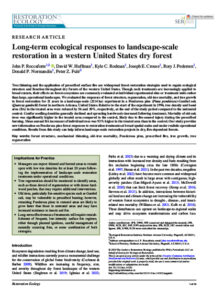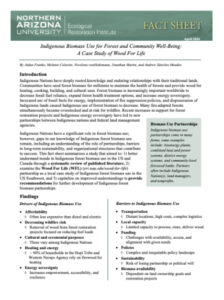Working Together to Restore:
Communities In Action
Living in the West often means learning to live with wildfire. Many communities and land managers recognize the threat of wildfire to homes, lives, and forests, and have been actively working together to develop community wildfire protection plans, restore forested areas in the wildland-urban interface, protect watersheds, and promote Firewise principles for homeowners.
Communities like Flagstaff, Arizona and collaborative organizations like the Four Forest Restoration Initiative (4FRI), Greater Flagstaff Forest Partnership (GFFP), and the Flagstaff Watershed Protection Project (FWPP) are leaders in innovative restoration opportunities and partnerships as well as local outreach and education.
To learn more about these partnerships and initiatives, or how to better protect your community from wildfire, visit these websites:
The Economic and Social Benefits of Restoration
Healthy forests provide a myriad of economic and social benefits. Forests offer ecosystem services like clean water, carbon storage, flood and erosion control, and recreation opportunities, and throughout much of the West they often support vital tourist economies. Restorative mechanical thinning treatments make economic and ecological sense because they promote economic development in local economies while reducing wildfire risk and restoring ecosystem health.
To better understand the economic trade-offs of restoration, the ERI has worked closely with Northern Arizona University-affiliated and independent economists on full-cost accounting and cost avoidance studies that examine the direct, indirect, and hidden costs of severe wildfires. In addition to economic analyses, ERI studies social impacts of wildfire.
Below are several of our most recent white papers that explore the social and economic implications of wildfire and restoration:
- WHITE PAPER: Assessment of Community Wildfire Protection Plans (CWPP) in Arizona and Throughout the West (2020)
- WHITE PAPER: Wildfire Trends Across the Western US: Forest Fires Have Increased in Size, Severity, and Frequency Across Western Forests (2020)
- WHITE PAPER: Administrative and Legal Review Opportunities for Collaborative Groups (2015)
- WHITE PAPER: Flagstaff Watershed Protection Project: Creating Solutions through Community Partnerships(2015)
- WHITE PAPER: A Full Cost Accounting of the 2010 Schultz Fire (2013)
- WHITE PAPER: The Efficacy of Hazardous Fuel Treatments: A Rapid Assessment of the Economic and Ecologic Consequences of Alternative Hazardous Fuel Treatments (2013)
- WHITE PAPER: Forest Restoration Treatments: Their Effect on Wildland Fire Suppression Costs (2013)
- WHITE PAPER: Workforce Needs of the Four Forest Restoration Initiative Project: An Analysis (2012)
- WHITE PAPER: Ecological Restoration as Regional Economic Stimulus (2010)
Partnerships
The ERI maintains a national profile of excellence in the field of forest restoration and fire through scholarly activities, media, testimony, and participation at national meetings and other venues. Through this engagement, ERI has established more than 200 partnerships with governments, organization, and others in Arizona, the West, and across the nation.



Long-term ecological responses to landscape-scale restoration in a western United States dry forest
Tree thinning and prescribed surface fire are common forest restoration strategies in the dry forests of the western United States. These treatments are often assessed at small scales rather than across large areas. This study evaluated forest structure, regeneration, old-tree mortality, and tree growth over 21 years in a large (2114 ha) Ponderosa pine-Gambel oak forest in northern Arizona. By the end of the study, tree density and basal area in the treated area were reduced by 56% and 38%, respectively, compared to the untreated control. Conifer seedling densities generally declined while hardwood sprouting increased post-treatment. Old oak tree mortality was higher in the treated area, likely due to fire injury. The mean annual basal area increment of individual trees was 93% higher in the treated area than in the control. These findings offer valuable insights for large-scale restoration efforts in dry, fire-dependent forests.
Return on investments in restoration and fuel treatments in frequent-fire forests of the American west: A meta-analysis
Arid forests in the American West are overly dense and need fuel reduction and fire regime restoration. Forest restoration efforts, such as thinning and prescribed burning, aim to reduce wildfire risks. Despite their importance, the cost-effectiveness of these programs is not well understood. This study conducted a meta-analysis of 120 observations from 16 studies over the past two decades to evaluate the benefits and costs of forest restoration and fuel treatments. Results showed significant variation in benefits, from enhanced ecosystem services to avoided wildfire costs. In high-value, at-risk watersheds, every dollar invested in restoration yielded up to seven dollars in benefits, achieving a 600% return on investment.



